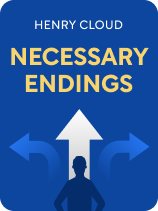

This article is an excerpt from the Shortform book guide to "Necessary Endings" by Henry Cloud. Shortform has the world's best summaries and analyses of books you should be reading.
Like this article? Sign up for a free trial here.
When will you know when it’s time to move on? How should you assess difficult situations and relationships?
It’s important to determine where to implement endings in your life so you aren’t stuck in the past. Necessary Endings by Henry Cloud offers suggestions for assessing both the difficult situations and relationships in your life.
Continue reading to make hard assessments of areas in your life.
Assess Difficult Situations
When figuring out when it’s time to move on from difficult situations in your life, look out for three types of negative situations: situations that are good but not great, mediocre situations that are unlikely to improve, and lost causes.
End Situations That Are Good but Not Great
Cloud recommends you end situations that are good, but not great. While it may seem counterintuitive to bring an end to a good situation, Cloud argues that you should only make room in your life for the situations that serve you best. When you stay in a situation that’s good but not great, you deprive yourself of the opportunity to do something that’s even better for you.
End Mediocre Situations That Are Unlikely to Improve
Also aim to end situations that are mediocre and unlikely to improve. Cloud argues that it’s easy to stay in mediocre situations, telling yourself that they might someday turn around. To avoid this, objectively assess whether the situation is likely to improve. Consider past patterns, as they’re likely to predict future outcomes. As you look to the past to chart the future, take note of any recent changes that may change the outcome of the situation.
End Lost Causes
Finally, end situations that are lost causes. According to Cloud, some situations are obviously beyond saving. The best thing you can do in those situations is to end them immediately, to free up resources that would be better utilized elsewhere.
For example, imagine you work at a tech company that still devotes a significant chunk of its resources to manufacturing VCRs, despite the fact that they haven’t sold well in over a decade. Your best course of action would be to end VCR production immediately, and use the budget to improve and market your other products.
Cloud notes that to identify the three types of unproductive situations, you must have clear goals in mind. If you don’t set goals and standards for your endeavors, you’ll be unable to measure whether a situation is good, great, mediocre, or a lost cause.
Lastly, when assessing any situation, consider whether it depletes resources faster than it brings them in. Situations that require a large investment to produce a minimal return should be ended, as they are unlikely to be productive in the long run.
Assess Difficult Relationships
As opposed to more generalized situations, Cloud offers a separate set of strategies for assessing relationships that may need to end. He recommends that you consider the structural factors around the relationship, use character as a basis for assessment, and put the ball in the other person’s court.
Consider Structural Factors When Assessing Relationships
When you have an issue with someone’s behavior, you should consider the structural factors that influence that behavior—this is especially relevant in the context of employees. You should first assess whether the person is in the right position. Even the most talented employees will struggle in ill-fitting roles. Then, determine whether the person has the institutional support they need to succeed. When employees fail, it may often be due to issues beyond their control, such as a lack of resources or coaching in their work environment.
Use Character to Assess Relationships
Once you’ve considered the structural factors at play, assess relationships based on your impression of the other person’s character. Cloud claims that character is predictive of whether or not people will be receptive to change and feedback.
According to Cloud, people can generally be sorted into three categories based on their character. There are responsible people, irresponsible people, and dangerous people. Cloud offers different strategies for dealing with each type of person. (Cloud notes that people are too complicated to truly fall into three simple categories; however, these three categories can still be a useful heuristic for determining which relationships to end.)
1) Responsible people (Cloud refers to them as “wise people”): Responsible people are characterized by their ability to take ownership of their actions. They’re able to admit and apologize when their mistakes have hurt others, and they readily incorporate feedback and change unwanted behaviors.
2) Irresponsible people (Cloud refers to them as “fools”): As you might expect, irresponsible people are in many ways the polar opposites of responsible people. Irresponsible people are unable to take responsibility for their actions, instead finding an external factor to blame for any mistakes they make. When pressed about their behaviors, they’ll deflect or become heated and defensive.
3) Dangerous people (Cloud refers to them as “evil people”): Dangerous people are completely unlike the first two groups. Whereas both responsible and irresponsible people may sometimes cause harm by accident, dangerous people intend to harm others with their words and their actions. They are unsafe to be around.
Let the Other Person Decide
If, after assessing someone’s character, you’re still not certain whether to end your relationship with them, it can help to let the other person decide (Cloud refers to this process as “self-selection”). Letting the other person decide entails communicating your standards to the other person and allowing them to choose whether they want to live up to those standards.
Cloud points out that allowing the other person to make the decision has benefits for both parties. If you struggle with guilt when imposing consequences in relationships, allowing the other person to make the decision can help alleviate this feeling. This style of decision-making can feel more inclusive to the other person—instead of passing down behavioral mandates, you’re including them in the decision-making process.

———End of Preview———
Like what you just read? Read the rest of the world's best book summary and analysis of Henry Cloud's "Necessary Endings" at Shortform.
Here's what you'll find in our full Necessary Endings summary:
- That pulling out of a bad situation is the best way to move forward in life
- How to assess which situations and relationships need to end
- How to make sure that your endings stick






